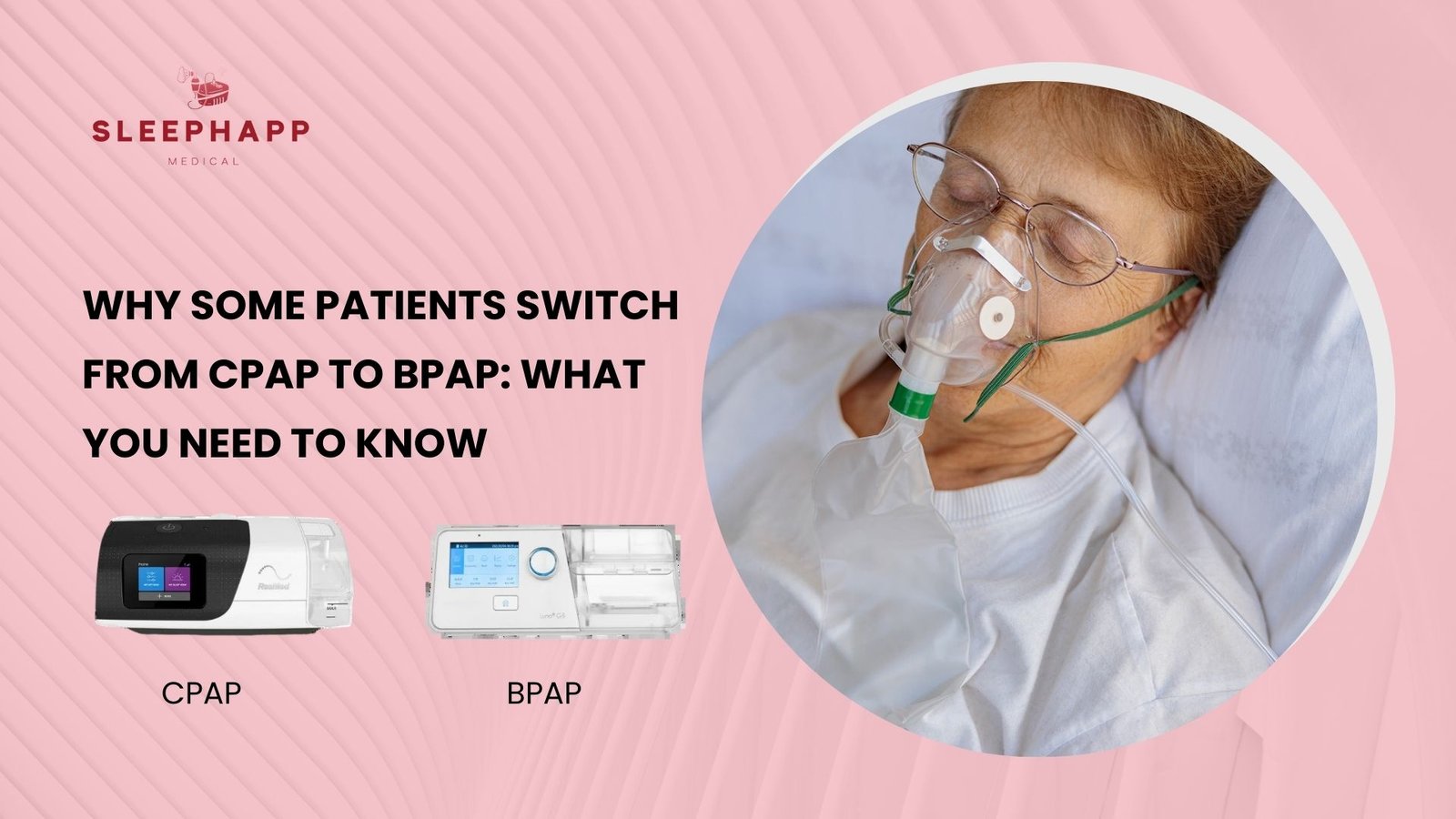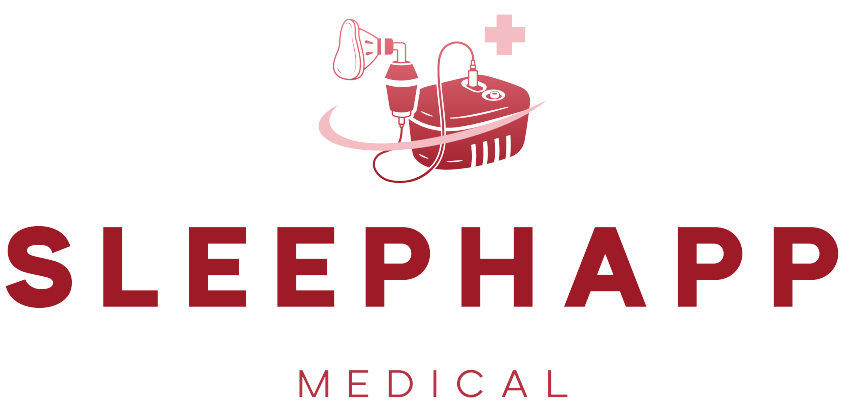Why Some Patients Switch from CPAP to BPAP: What You Need to Know
Home » Why Some Patients Switch from CPAP to BPAP: What You Need to Know

Table of Contents
Sleep apnea is a condition that causes breathing to stop and start during sleep. Many patients use CPAP (Continuous Positive Airway Pressure) machines to treat it. However, only some find CPAP comfortable or practical. Some people switch to BPAP (Bi-level Positive Airway Pressure). This article explains why patients make this switch and how BPAP can help.
What is CPAP Therapy?
CPAP stands for Continuous Positive Airway Pressure. It is a common treatment for sleep apnea, a condition in which breathing stops and starts during sleep. CPAP therapy helps by sending a steady flow of air to the lungs, improving sleep and overall health.
How Does CPAP Work?
A CPAP machine pushes air through a mask you wear while sleeping. This steady airflow keeps your throat open so your breathing doesn’t stop.
Example:
Imagine blowing into a straw inside a balloon. The air keeps the balloon inflated. CPAP works the same way, keeping your airway open all night.
Benefits of CPAP (Continuous Positive Airway Pressure)
Better Sleep Quality
CPAP helps people with sleep apnea sleep better. It keeps the airways open with a steady flow of air, which stops snoring and prevents breathing interruptions. With CPAP, sleep becomes smooth and restful. People wake up feeling fresh and ready for the day. Better sleep improves physical and mental health.
More Energy During the Day
Sleep apnea can make you feel tired all day. CPAP fixes this by keeping oxygen levels steady at night. This leads to deeper sleep and less daytime drowsiness. Users often feel more alert, focused, and productive. For many, CPAP greatly boosts energy and quality of life.
Protects Heart Health
Sleep apnea can harm your heart, increasing risks like high blood pressure and heart problems. CPAP helps by regulating breathing and oxygen levels. This reduces strain on the heart and improves overall heart health. Using CPAP long-term can even lower blood pressure.
Improves Mental and Emotional Well-Being
Poor sleep is insufficient for the brain and can make you moody, anxious, and forgetful. CPAP helps you breathe better and get more oxygen. This can lift your mood, reduce stress, and improve your memory. Over time, it makes you feel more transparent and balanced.
Safe and Adjustable Treatment
CPAP is a simple way to treat sleep apnea without surgery. It is easy to use and fits different needs. Modern CPAP machines have helpful features, including adjustable pressure, heated humidifiers, and soft masks. CPAP is safe, effective, and has no surgery risks.
Common Problems with CPAP
CPAP (Continuous Positive Airway Pressure) is helpful for sleep apnea, but some people face problems while using it. Here are common issues and their reasons:
Mask Feels Uncomfortable
Many people find the mask hard to wear. It may feel too tight or too loose or not fit properly. A poor fit can also cause air leaks, which reduce the treatment’s effectiveness.
Air Pressure Feels Unnatural
The steady airflow can feel strange, especially for new users. Some find it hard to sleep or feel like they are not breathing normally.
Dryness and Congestion
CPAP can cause dryness in the mouth, nose, or throat. It may also lead to a stuffy nose, making breathing harder.
Skin Irritation or Pressure Marks
The mask or straps can irritate the skin, causing redness, rashes, or even small sores on the face.
Noise from the Machine
While modern CPAP machines are quieter, some people find the sound distracting. It may make it hard to relax or sleep.
How to Fix These Problems
These problems can be solved with help from your doctor or CPAP provider. You can:
- Ask for a different mask size or style.
- Use a CPAP machine with adjustable air pressure.
- Try a humidifier to reduce dryness.
- Learn tips to stay comfortable with the mask.
By fixing these issues, CPAP therapy can work better for you. It takes time, but it helps improve your sleep and health.
What is BPAP Therapy?
BPAP stands for Bilevel Positive Airway Pressure. It is a treatment that helps people with breathing problems. Doctors often use it for conditions like sleep apnea, COPD (Chronic Obstructive Pulmonary Disease), and other breathing issues.
BPAP is different from CPAP. CPAP gives one steady air pressure, but BPAP gives two. It has a higher pressure when you breathe in and a lower pressure when you breathe out, making it easier and more comfortable to breathe.
BPAP machines have innovative technology. They watch how you breathe and give the right amount of air pressure. This helps keep oxygen levels regular and prevents problems from poor breathing.
How BPAP Works
BPAP therapy helps you breathe more naturally by giving two pressure levels:
Higher Pressure for Breathing In (IPAP)
- When you take a deep breath, the machine provides a higher pressure called Inspiratory Positive Airway Pressure (IPAP). This keeps your airway open and helps oxygen reach your lungs. It also reduces the effort needed to take a deep breath.
Lower Pressure for Breathing Out (EPAP)
- When you breathe out, the machine switches to a lower pressure called Expiratory Positive Airway Pressure (EPAP). This stops your airway from collapsing, makes it easier to exhale, and helps airflow feel more natural.
Features of BPAP Machines
BPAP machines have special features to make therapy more effective and comfortable. Here are some key features:
Adjustable Pressure Settings
BPAP machines can change air pressure based on the patient’s needs. They provide higher pressure when inhaling and lower pressure when exhaling, making breathing feel more natural and comfortable.
Humidifiers
Many machines have built-in humidifiers to stop dryness in the throat and nose. The moist air reduces irritation and makes using the machine more pleasant.
Therapy Progress Monitors
These machines often track therapy progress. They measure air pressure, oxygen levels, and breathing patterns, which doctors can use to adjust settings and improve treatment.
Quiet Operation
BPAP machines are usually very quiet. This helps patients sleep peacefully without being disturbed by noise.
Portable Design
Some BPAP machines are small and lightweight. They are easy to carry while traveling, so therapy can continue even away from home.
Advanced-Data Features:
Modern BPAP machines can share therapy data with patients and doctors. This helps make changes to improve treatment and achieve better results.
Why Do Patients Switch from CPAP to BPAP?
Better for Certain Conditions
Some medical conditions, like central sleep apnea (CSA) or lung diseases, require more than steady air pressure. CPAP machines provide one constant pressure, which may not be enough for these conditions. BPAP machines are better because they provide two different pressure levels. One pressure helps you inhale, and a lower one helps you exhale. This makes BPAP more suitable for people with serious breathing problems.
More Comfortable
Many patients switch to BPAP because it is more comfortable. CPAP machines deliver air at one steady pressure, which some people find hard to adjust. BPAP is different. It changes pressure levels when you breathe in and out, making it feel more natural and less rigid. People who feel stressed or uncomfortable using CPAP often find BPAP much easier to use.
Higher Compliance
Using therapy devices regularly is essential for good results. Patients often stick to BPAP therapy longer than CPAP therapy. This is because BPAP feels easier to use. The machine adjusts to the way you breathe, making therapy feel more natural. When therapy feels comfortable, people are more likely to continue using it, which helps improve their health over time.
Advanced Technology
Modern BPAP machines have better technology compared to older devices. They are quieter, so they don’t disturb sleep. They also come with features you can customize. For example, you can adjust settings to match your Comfort level. These machines are easier to use, even for people who need to be tech-savvy. BPAP’s advanced features make it a better choice for many patients.
How to Switch from CPAP to BPAP
Switching from CPAP (Continuous Positive Airway Pressure) to BPAP (Bilevel Positive Airway Pressure) is a big decision. It may help if your current therapy isn’t working well. BPAP has advanced features that can be more comfortable and effective. Here is an easy step-by-step guide to help you make the switch.
Talk to Your Doctor
Always consult your doctor first. They will check your condition to see if BPAP is right for you. Your doctor might suggest a sleep study to learn more about your needs. This test helps decide if BPAP is necessary. Use this time to share any problems you have with CPAP, like discomfort or poor sleep.
Check Costs and Insurance
Because of their advanced features, BPAP machines cost more than CPAP machines. Compare prices to understand the difference. Also, check if your insurance covers BPAP. Knowing this will help avoid unexpected costs and make the process easier.
Try BPAP Before You Switch
Ask your healthcare provider if you can try a BPAP machine first. A trial period helps you see if BPAP is more comfortable and practical. It also allows you to get used to its features before making a final decision.
Work with a Specialist
If your doctor approves BPAP, work with a specialist to adjust the machine. BPAP has two pressure settings: one for inhaling and one for exhaling. Your specialist will set these to match your needs. Proper settings make the therapy more comfortable and improve your sleep.
Follow Up Regularly
After switching to BPAP, keep checking your progress. Visit your doctor regularly to see if the therapy is working. They can adjust the machine’s settings if needed. Regular follow-ups ensure you get the best results and solve any issues quickly.
Switching to BPAP can improve your sleep and health. Take your time, talk to your doctor, and follow these steps carefully. With the right approach, BPAP therapy can be an excellent solution for better sleep and Comfort.
Conclusion
Some patients switch from CPAP to BPAP for better Comfort or medical reasons. BPAP is often a better choice for people with complex conditions like CSA or lung diseases. It offers advanced features and more natural breathing support.
If CPAP is not working for you, talk to your doctor. They can help you decide if BPAP is the right choice. With the proper treatment from Sleephapp Medical, you can sleep better and improve your health.
